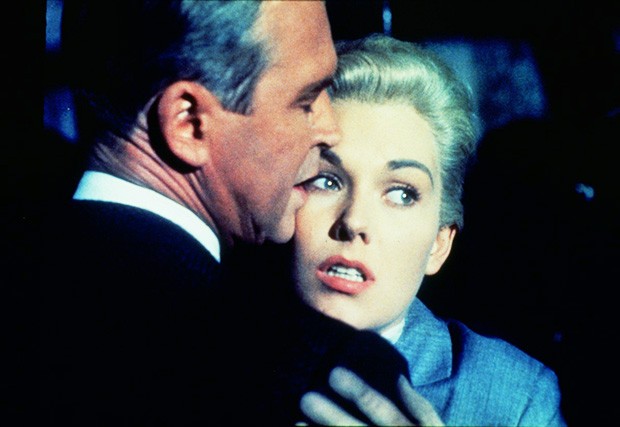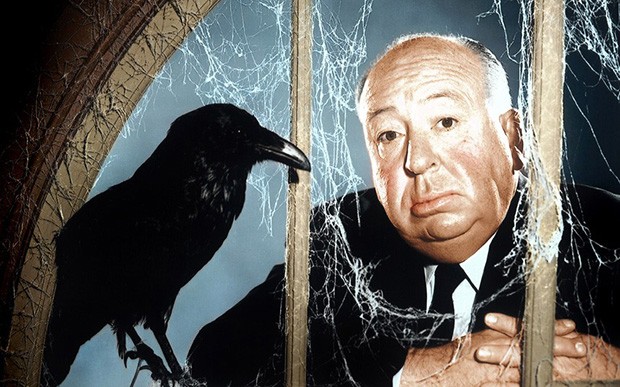Alfred Hitchcock: 116 years of contradiction, precision and suspense
 James Stewart and Kim Novak in Alfred Hitchcock's Vertigo: "How can a man — and his work — be so many apparently contradictory things to so many different people?" | Image courtesy of Paramount Pictures
James Stewart and Kim Novak in Alfred Hitchcock's Vertigo: "How can a man — and his work — be so many apparently contradictory things to so many different people?" | Image courtesy of Paramount Pictures
Among the many film courses that the late, great Marc Gervais taught during his 35 years in Communication Studies at Concordia was a well-known class on Alfred Hitchcock that I attended in the early 1980s.
In addition to watching Hitchcock classics on the big screen — such as The Birds, North By Northwest and, of course, Psycho — we listened to Marc’s passionate accompanying lectures highlighting Ingrid Bergman’s exquisite performance in Notorious, for instance, or the layered temporalities and soundscapes of Vertigo, the complex relations and voyeurism in Rear Window, or the extensive religious themes that run through so many of his films.
Hitchcock’s enduring legacy and his interest for cultural studies lie in part in how his films continue to resonate in multifaceted ways.
Film historian Thomas Elsaesser quizzically observed:
To each his or her own … Writers have identified a misogynist Hitchcock and feminist Hitchcock, an Oedipal Hitchcock, a homophobe Hitchcock and a ‘queer’ Hitchcock. There is the Cold-War anti-communist Hitchcock … and the ‘hot war’ anti-fascist Hitchcock … He has made fun of psychoanalysis … but he is Jacques Lacan’s best interpreter. There is the Gothic-Romantic, a Victorian, and Edwardian Hitchcock … and a modernist Hitchcock.
As Elsaesser notes, “How can a man — and his work — be so many apparently contradictory things to so many different people?”
In a similar vein, feminist film theorist, Laura Mulvey remarks in her book Death 24x a Second (2006) that even decades after Psycho’s 1960 release, “its significance as a milestone waxes rather than wanes.” She also describes its industrial positioning at a crossroads of old Hollywood and emergent low-budget, scaled-down film productions.
Hitchcock made cameo appearances in most of his films, which became hugely popular: he purportedly told François Truffaut that he needed to appear early in his films, so as not to distract from the story’s suspenseful unfolding.
Hitchcock’s enduring legacy and his interest for cultural studies lies in part in how his films continue to resonate and influence in multifaceted ways.
Film historian Thomas Elsaesser quizzically observed:
To each his or her own …Writers have identified a misogynist Hitchcock and feminist Hitchcock, an Oedipal Hitchcock, a homophobe Hitchcock and a ‘queer’ Hitchcock. There is the Cold-War anti-communist Hitchcock … and the ‘hot war’ anti-fascist Hitchcock … He has made fun of psychoanalysis … but he is Jacques Lacan’s best interpreter. There is the Gothic-Romantic, a Victorian, and Edwardian Hitchcock … and a modernist Hitchcock.
As Elsaesser notes, “How can a man — and his work — be so many apparently contradictory things to so many different people?”
In a similar vein, feminist film theorist, Laura Mulvey remarks in her book Death 24x a Second (2006) that even decades afterPsycho’s 1960 release, “its significance as a milestone waxes rather than wanes.” She also describes its industrial positioning at a crossroads of old Hollywood and emergent low-budget, scaled-down film productions.
Hitchcock made cameo appearances in most of his films, which became hugely popular: he purportedly told François Truffaut that he needed to appear early in his films, so as not to distract from the story’s suspenseful unfolding.
It is well known that many, many filmmakers have paid tribute to Hitchcock, onscreen and in print; Trauffaut’s book-length interview is a case in point. In 2012, The Guardian even ran a multi-authored blog series called My Favourite Hitchcock Film.
And artists’ homages have also demonstrated Hitchcock’s broader cultural and aesthetic influences, as shown in the 1996 exhibition, Notorious: Alfred Hitchcock and Contemporary Art at the Museum of Modern Art, Oxford, and the more recent Christine Sprengler book Hitchcock and Contemporary Art (2014), in which the Western University academic identifies over 58 artists who quote the filmmaker in some way.
Hitchcock’s enduring legacy and his interest for cultural studies lies in part in how his films continue to resonate and influence in multifaceted ways.
Film historian Thomas Elsaesser quizzically observed:
To each his or her own …Writers have identified a misogynist Hitchcock and feminist Hitchcock, an Oedipal Hitchcock, a homophobe Hitchcock and a ‘queer’ Hitchcock. There is the Cold-War anti-communist Hitchcock … and the ‘hot war’ anti-fascist Hitchcock … He has made fun of psychoanalysis … but he is Jacques Lacan’s best interpreter. There is the Gothic-Romantic, a Victorian, and Edwardian Hitchcock … and a modernist Hitchcock.
As Elsaesser notes, “How can a man — and his work — be so many apparently contradictory things to so many different people?”
In a similar vein, feminist film theorist, Laura Mulvey remarks in her book Death 24x a Second (2006) that even decades afterPsycho’s 1960 release, “its significance as a milestone waxes rather than wanes.” She also describes its industrial positioning at a crossroads of old Hollywood and emergent low-budget, scaled-down film productions.
Hitchcock made cameo appearances in most of his films, which became hugely popular: he purportedly told François Truffaut that he needed to appear early in his films, so as not to distract from the story’s suspenseful unfolding.
It is well known that many, many filmmakers have paid tribute to Hitchcock, onscreen and in print; Trauffaut’s book-length interview is a case in point. In 2012, The Guardian even ran a multi-authored blog series called My Favourite Hitchcock Film.
And artists’ homages have also demonstrated Hitchcock’s broader cultural and aesthetic influences, as shown in the 1996 exhibition, Notorious: Alfred Hitchcock and Contemporary Art at the Museum of Modern Art, Oxford, and the more recent Christine Sprengler book Hitchcock and Contemporary Art (2014), in which the Western University academic identifies over 58 artists who quote the filmmaker in some way.
 Alfred Hitchcock | Photo courtesy Everett Collection / Rex Features
Alfred Hitchcock | Photo courtesy Everett Collection / Rex Features
It is well known that many, many filmmakers have paid tribute to Hitchcock, onscreen and in print; Trauffaut’s book-length interview is a case in point. In 2012, The Guardian even ran a multi-authored blog series called My Favourite Hitchcock Film.
And artists’ homages have also demonstrated Hitchcock’s broader cultural and aesthetic influences, as shown in the 1996 exhibition, Notorious: Alfred Hitchcock and Contemporary Art at the Museum of Modern Art, Oxford, and the more recent Christine Sprengler book Hitchcock and Contemporary Art (2014), in which she identifies over 58 artists who quote the filmmaker in some way.
A few years after graduating from Communication Studies at Concordia, I worked as a film technician, more specifically as on-set script supervisor for filmmakers such as Atom Egoyan and Patricia Rozema.
While experiencing first-hand the range of montage skills that film directors bring to the production process, I recalled Marc elucidating how Hitchcock was so precise in his pre-production storyboards that he would only shoot exactly the footage he needed to edit his film in his vision. No alternative cuts were available: that’s how masterfully he controlled his own medium.
Earlier this month, British author Hanif Kureishi recently revered Hitchcock’s unmatched ability to structure narrative and create anxiety in his audiences, “By the time you’re three quarters of the way through the film, you’re extremely anxious about the outcome. You really want to know what’s going to happen. How did he do that? It’s a fascinating accomplishment.”
It certainly is.
Find out more about Communication Studies and Film Studies at Concordia. Read about Concordia’s first-ever winner of the Marc Gervais Prize.